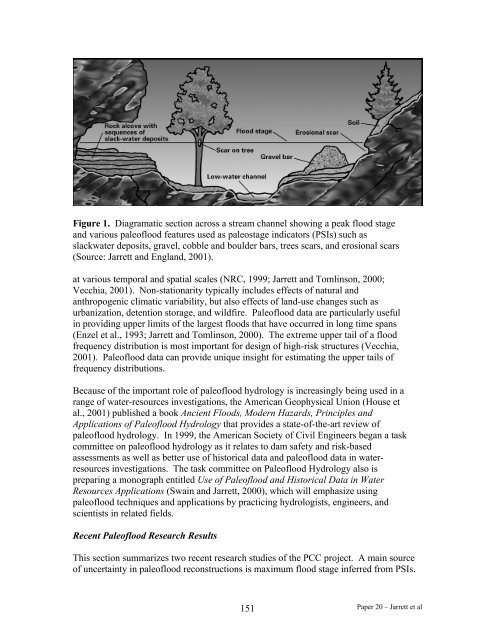Hydrologic Issues for Dams - Association of State Dam Safety Officials
Hydrologic Issues for Dams - Association of State Dam Safety Officials
Hydrologic Issues for Dams - Association of State Dam Safety Officials
Create successful ePaper yourself
Turn your PDF publications into a flip-book with our unique Google optimized e-Paper software.
Figure 1. Diagramatic section across a stream channel showing a peak flood stageand various pale<strong>of</strong>lood features used as paleostage indicators (PSIs) such asslackwater deposits, gravel, cobble and boulder bars, trees scars, and erosional scars(Source: Jarrett and England, 2001).at various temporal and spatial scales (NRC, 1999; Jarrett and Tomlinson, 2000;Vecchia, 2001). Non-stationarity typically includes effects <strong>of</strong> natural andanthropogenic climatic variability, but also effects <strong>of</strong> land-use changes such asurbanization, detention storage, and wildfire. Pale<strong>of</strong>lood data are particularly usefulin providing upper limits <strong>of</strong> the largest floods that have occurred in long time spans(Enzel et al., 1993; Jarrett and Tomlinson, 2000). The extreme upper tail <strong>of</strong> a floodfrequency distribution is most important <strong>for</strong> design <strong>of</strong> high-risk structures (Vecchia,2001). Pale<strong>of</strong>lood data can provide unique insight <strong>for</strong> estimating the upper tails <strong>of</strong>frequency distributions.Because <strong>of</strong> the important role <strong>of</strong> pale<strong>of</strong>lood hydrology is increasingly being used in arange <strong>of</strong> water-resources investigations, the American Geophysical Union (House etal., 2001) published a book Ancient Floods, Modern Hazards, Principles andApplications <strong>of</strong> Pale<strong>of</strong>lood Hydrology that provides a state-<strong>of</strong>-the-art review <strong>of</strong>pale<strong>of</strong>lood hydrology. In 1999, the American Society <strong>of</strong> Civil Engineers began a taskcommittee on pale<strong>of</strong>lood hydrology as it relates to dam safety and risk-basedassessments as well as better use <strong>of</strong> historical data and pale<strong>of</strong>lood data in waterresourcesinvestigations. The task committee on Pale<strong>of</strong>lood Hydrology also ispreparing a monograph entitled Use <strong>of</strong> Pale<strong>of</strong>lood and Historical Data in WaterResources Applications (Swain and Jarrett, 2000), which will emphasize usingpale<strong>of</strong>lood techniques and applications by practicing hydrologists, engineers, andscientists in related fields.Recent Pale<strong>of</strong>lood Research ResultsThis section summarizes two recent research studies <strong>of</strong> the PCC project. A main source<strong>of</strong> uncertainty in pale<strong>of</strong>lood reconstructions is maximum flood stage inferred from PSIs.151Paper 20 – Jarrett et al

















